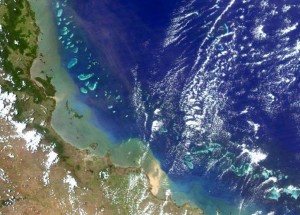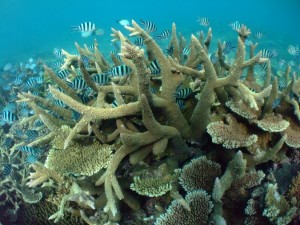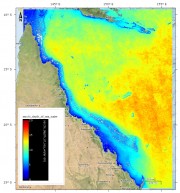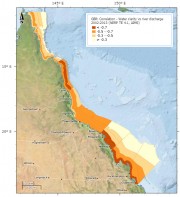NERP TE Project 4.1 - Tracking coastal turbidity over time and demonstrating the effects of river discharge events on regional turbidity in the GBR (AIMS)
Project summary
Turbidity is a measure of water clarity that quantifies the amount of small particles suspended in the water, and is a fundamental environmental parameter influencing coastal marine ecosystems. Turbidity reduces the light needed for photosynthesis by corals and seagrasses, and suspended particles also transport nutrients, pollutants and diseases. Previous research based on 3 years of turbidity data collected from 15 inshore reefs by the Reef Rescue Marine Monitoring Program has shown that it can take several months for water clarity to improve after river floods. This project will analyse a 12-year data set to demonstrate the explicit link between variations in discharge (sediments and nutrients) from the major rivers in each Natural Resource Management (NRM) region adjacent to the Great Barrier Reef (GBR) and seasonal and annual variations in water clarity in the inshore GBR.


Why this research is needed
Quantification of the relationship between terrestrial run-off and turbidity is critical to demonstrate that water quality in the inshore GBR can be improved through improved land management in adjacent catchments. The new knowledge generated by this project will improve the scientific basis underpinning the Australian Government's Reef Rescue program, Reef Plan and the refinement of water quality targets. The project will also determine the spatial extent of declining water quality on the inshore GBR and allow validation and calibration of a Receiving Waters Model.
Research-user focus
Specified research-users include the Great Barrier Reef Marine Park Authority, Department of Sustainability, Environment, Water, Populations and Communities, Queensland Department of Premier and Cabinet, Queensland Department of Environment and Heritage Protection, Queensland NRM bodies adjacent to the GBR, the agricultural industry and WWF.
Outcomes
- Specific quantitative relationships between river discharges and seasonal and annual variation in inshore water clarity on the GBR adjacent to each NRM region.
- Strengthened scientific basis for Reef Rescue and Reef Plan and the refinement of water quality targets.
- Data to assist validation and calibration of the Receiving Waters Model and a WQ Risk Analysis.
Reports, Publications and News
For more information see Project 4.1 'Tracking coastal turbidity over time and demonstrating the effects of river discharge events on regional turbidity in the Great Barrier Reef' on the NERP Tropical Ecosystems Hub site.
Datasets

This dataset consists of daily estimates of photic depth on the Great Barrier Reef from MODIS satellite imagery (from 2002 - 2015) using a quasi-analytical algorithm. This algorithm is based on a Type II linear regression of log-transformed satellite and in situ data (2002- 2012).
This algorithm was developed as part of data delivery for several NERP projects and was implemented into the NASA SeaDAS tool for processing MODIS imagery. This algorithm and its data products are now routinely run by the Bureau of Meteorology as part of the eReefs Water Quality Dashboard.

This dataset shows various statistics of photic depth across the Great Barrier Reef (GBR). Data are broken into 35 zones along and across the GBR and photic depth is derived from 11 years of MODIS Aqua data. The data included is:
1. The statistical strength of correlation between standardized photic depth and freshwater discharges the GBR.
2. The mean photic depth and the main physical environmental variables that need to be controlled for when assessing how volumes of river freshwater discharges influence photic depth.

Turbidity is a measure of water clarity that quantifies the amount of small particles suspended in the water, and is a fundamental environmental parameter influencing coastal marine ecosystems. Turbidity reduces the light needed for photosynthesis by corals and seagrasses, and suspended particles also transport nutrients, pollutants and diseases. Previous research based on 3 years of turbidity data collected from 15 inshore reefs by the Reef Rescue Marine Monitoring Program has shown that it can take several months for water clarity to improve after river floods.






